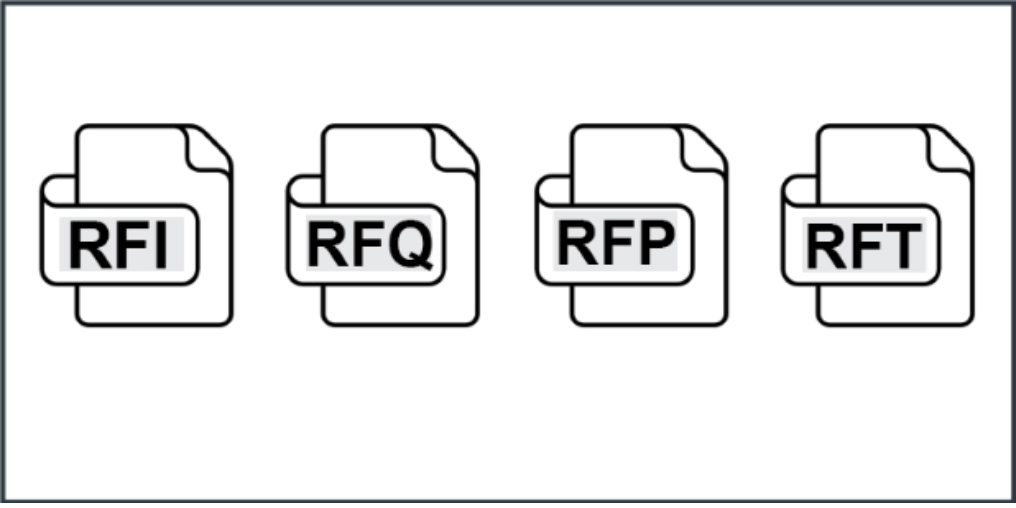Difference between RFI, RFQ, RFP and RFT in eTender

In the procurement world, various documents help facilitate the purchase of goods and services. Four commonly used documents are the Request for Proposal (RFP), Request for Quotation (RFQ), Request for Information (RFI), and Request for Tender (RFT). Each serves a unique purpose and is used at different stages of the procurement process. In the world of business procurement, understanding the differences between RFP (Request for Proposal), RFQ (Request for Quotation), RFI (Request for Information), and RFT (Request for Tender) is crucial. Each one helps both buyers and sellers communicate their needs and capabilities effectively. Here’s a simplified overview of each term:
Understanding the Variances Among RFI, RFQ, RFP, and RFT
In the realm of eTendering, distinguishing between RFI, RFQ, RFP, and RFT is crucial for vendors seeking government contracts. An RFI (Request for Information) gathers vendor data, helping buyers assess market capabilities. RFQ (Request for Quotation) solicits price quotes for specific goods or services, aiding buyers in cost comparison. RFP (Request for Proposal) invites detailed project proposals from vendors, outlining requirements and objectives. Lastly, RFT (Request for Tender) formalizes bidding invitations, detailing contract terms and conditions. With more eTendering platforms around, it's crucial for vendors to know these differences. It helps them compete better for government contracts and succeed in the procurement process. With the rise of tender consultancy services; vendors can now easily grasp these differences. This knowledge enables them to compete effectively and secure contracts during the procurement process:
1. Request for Information (RFI)
An RFI is used at the very beginning of the buying process. Think of it as a way for buyers to gather information about what’s available in the market. When a company is considering purchasing a product or service but isn't sure what options exist or what might be the best fit, they issue an RFI. Suppliers respond with details about their offerings, capabilities, and how they can meet the company’s needs. The goal of an RFI is to collect enough information to make informed decisions about next steps. It’s important to note that an RFI is not a request for a bid or price. It’s purely for information gathering.
2. Request for Quotation (RFQ)
An RFQ is used when the buyer knows exactly what they need and are ready to ask for pricing. If a company needs a specific product or service and the requirements are clear and detailed, they issue an RFQ. Suppliers respond with quotes for the cost of fulfilling those needs. RFQs are straightforward and focused on obtaining detailed pricing information from potential suppliers. This allows the buyer to compare prices and choose the best deal. The emphasis here is on cost, so the responses are typically more concise and to the point than those for an RFP.
3. Request for Proposal (RFP)
An RFP is used for more complex purchases where the buyer is looking for a detailed solution to their needs. This document asks suppliers to explain how they would meet the buyer’s requirements, including their approach, timeline, and costs. RFPs help buyers evaluate not just the price, but also the quality, experience, and added value that suppliers bring to the table. When a company issues an RFP, they are seeking a comprehensive proposal that outlines how the supplier plans to achieve the project goals and deliver the desired outcomes. The RFP process is more involved and requires a detailed evaluation of each proposal to determine the best fit.
4. Request for Tender (RFT)
An RFT is a formal and structured method of procurement often used by governments and large corporations. When a company has very specific requirements and seeks formal bids, they issue an RFT. Suppliers submit detailed and legally binding offers to provide the goods or services as specified. The RFT process involves strict compliance with the requirements outlined in the tender documents, and the submissions are thoroughly evaluated to select the best bid. RFTs ensure transparency and fairness in the procurement process, often including detailed specifications, conditions, and evaluation criteria.
Simple Break Down of Each Term:
In the business world, understanding the differences between RFP, RFQ, RFI, and RFT is crucial for effective procurement. Here's a simple explanation of each word:
1. Request for Information (RFI):
- Purpose:To gather information about potential suppliers and their offerings.
- When to Use:When you are exploring options and need to understand what's available in the market.
- Content:Suppliers provide general information about their products, services, and capabilities.
- Outcome:Helps narrow down potential suppliers and understand their solutions better.
2. Request for Quotation (RFQ):
- Purpose:To get detailed pricing for specific goods or services.
- When to Use:When you know exactly what you need and want to compare prices from different suppliers.
- Content:Detailed specifications of the product or service, and suppliers provide their prices.
- Outcome:Enables you to compare prices and select the most cost-effective option.
3. Request for Proposal (RFP):
- Purpose:To receive detailed proposals on how suppliers would meet your needs, including their approach, timeline, and costs.
- When to Use:When your requirements are complex and you need a comprehensive solution.
- Content:Detailed requirements and criteria for evaluation, and suppliers provide thorough proposals.
- Outcome:Helps you evaluate both the cost and quality of different suppliers' solutions, leading to a well-informed decision.
4. Request for Tender (RFT):
- Purpose:To invite suppliers to submit formal bids for a well-defined project or procurement need.
- When to Use:Often used by governments and large organizations for formal procurement processes.
- Content:Detailed project specifications and legal requirements, and suppliers submit formal, binding bids.
- Outcome:Ensures a transparent and fair selection process, with a focus on meeting all specified requirements.
Conclusion:
RFIs, RFQs, RFPs, and RFTs are essential tools in the procurement process, each serving a distinct purpose. An RFI is for gathering preliminary information and understanding what’s available in the market. An RFQ focuses on obtaining detailed pricing for specific needs. An RFP seeks comprehensive proposals for complex solutions, evaluating both cost and quality. An RFT is a formal request for detailed bids, often used in large-scale or government procurement.
Understanding when and how to use each type of request ensures effective communication between buyers and suppliers, leading to better decision-making and successful procurement outcomes. By understanding the distinctions between these procurement methods, both buyers and suppliers can navigate the tendering process effectively and achieve successful outcomes. Whether a company is looking for initial information, specific pricing, detailed proposals, or formal bids, using the right tool for the job simplifies the process and helps achieve the best results.
 By Admin
By Admin

